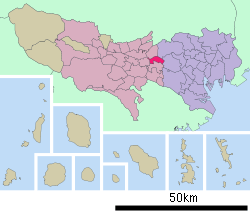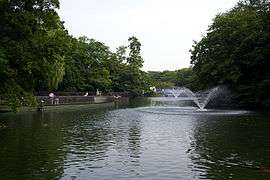Musashino, Tokyo
Musashino (武蔵野市, Musashino-shi) is a city located in the western portion of Tokyo Metropolis, Japan. As of 1 February 2016, the city had an estimated population of 143,868, and a population density of 13,090 persons per km². Its total area is 10.98 square kilometres (4.24 sq mi).[1]
Musashino 武蔵野市 | |
|---|---|
 Musashino City Hall | |
 Flag  Seal | |
 Location of Musashino in Tokyo | |
 Musashino | |
| Coordinates: 35°43′3.8″N 139°33′57.8″E | |
| Country | Japan |
| Region | Kantō |
| Prefecture | Tokyo |
| Area | |
| • Total | 10.98 km2 (4.24 sq mi) |
| Population (February 2016) | |
| • Total | 143,686 |
| • Density | 13,090/km2 (33,900/sq mi) |
| Time zone | UTC+9 (Japan Standard Time) |
| Symbols | |
| • Tree | Magnolia kobus, Zelkova serrata, Cornus florida |
| • Flower | Lespedeza, Lithospermum purpurocaeruleum, Orychophragmus, Azalea, Daphne odora, Narcissus, Hibiscus mutabilis, Ipomoea nil, Chrysanthemum |
| Phone number | 0422-51-5131 |
| Address | 2-2-28 Midori-cho, Musashino-shi, Tokyo 180-8777 |
| Website | www |

Geography
Musashino is located in the Musashino Terrace of central Tokyo Metropolis, bordered by the 23 Special Wards of Tokyo.
Musashino is composed of the following neighborhoods: Kichijoji Kitamachi, Kichijoji Higashicho, Kichijoji Honcho, Kichijoji Minamicho, Kyonancho, Gotenyama, Sakai, Sakurazutumi, Sekimae, Nakacho, Nishikubo, Midoricho, and Yahatacho.[2] Kichijōji includes the source of the Kanda River.
Surrounding municipalities

- Tokyo Metropolis
- Suginami-ku
- Nerima-ku
- Mitaka
- Koganei
- Nishitōkyō
History
The area of present-day Musashino was part of ancient Musashi Province. In the post-Meiji Restoration cadastral reform of July 22, 1878, the area became part of Kitatama District in Kanagawa Prefecture. The village of Musashino was created on April 1, 1889 with the establishment of municipalities law. Kitatama District was transferred to the administrative control of Tokyo Metropolis on April 1, 1893. Musashino was elevated to town status in 1928. Nakajima Aircraft Company has an aircraft engine plant in Musashino, which became a target for American bombers in World War II. Musashino was elevated to city status on November 3, 1947.
Economy
Musashino is largely a bedroom community for central Tokyo.
The anime and manga company Coamix has its headquarters in the Kichijōji neighborhood of Musashino.[3] At one time Studio Ghibli was located in Kichijōji.[4] Several other animation studios are located in Musashino, including J.C.Staff,[5] Artland, Studio Ponoc, Production I.G, Bee Train, and Tatsunoko Production.
The electrical engineering and software company Yokogawa Electric has its headquarters in Nakacho, Musashino. Tokyo Musashino City FC, a football (soccer) club, is also located there.
Education
Universities and colleges
Primary and secondary schools
- Musashino has 12 public elementary schools and six public middle schools operated by the Musashino city government. There are also three private elementary schools, two private middle schools and two private combined middle/high schools.
- The city also has two public high schools operated by the Tokyo Metropolitan Government Board of Education.
International schools
- Little Angels International School, a private international school, previously had a campus in Kichijōji, Musashino.[6]
Transportation
Railways
Highways
- Musashino is not served by any national highways or expressways
Local attractions
- Inokashira Park
- Musashino Central Park
- Musashino Municipal Athletic Stadium
- Musashino Sports Complex
Sister cities
Musashino in popular culture
- Satoshi Kon's anime series Paranoia Agent and Oyuki Konno's shōjo novel series Maria-sama ga Miteru take place in Musashino.
- Shōhei Ōoka's 1951 novel A Wife in Musashino (Musashino Fujin) is a drama in which a moral and stoic woman, trapped in a loveless marriage with a selfish and morally decadent man, becomes implicated against her will in what looks like an affair with her younger cousin. The story ends tragically as she is let down by him as well as by her husband. Kenji Mizoguchi made the story into a film in 1951, starring Kinuyo Tanaka and Masayuki Mori.
- Innocent Grey's 2007 visual novel Kara no Shoujo features many scenes set in Musashino in 1956. Inokashira Park in particular serves as a pivotal setting for much of the story.
- In the Yokohama Kaidashi Kikō manga by Hitoshi Ashinano, Musashino is the "former capital of the East" in a post-Apocalyptic Japan in which the ocean level continually rises, implying Tokyo itself had been submerged many years before it.
References
- 武蔵野市. Retrieved 2016-05-28.
- Mapion. 住所一覧から地図を検索 > 関東 > 東京都 > 武蔵野市 地図. Retrieved 2012-02-01.
- "事業概要." "【住所】 [出版コンテンツ事業部(編集部)・キャラクター事業部・総務部] 〒180-0004 東京都武蔵野市吉祥寺本町 2-4-14 メディ・コープビル8 3F TEL/0422-29-0414(代表) FAX/0422-29-0413"
- "The Animerica Interview: Takahata and Nosaka: Two Grave Voices in Animation." Animerica. Volume 2, No. 11. Page 11. Translated by Animerica from: Takahata, Isao. Eiga o Tsukurinagara, Kangaeta Koto ("Things I Thought While Making Movies") Tokuma Shoten, 1991. Originally published in Animage, June 1987. This is a translation of a 1987 conversation between Takahata and Akiyuki Nosaka. "Kichijoji is the Tokyo area where "Studio Ghibli," frequent Takahata collaborator Hayao Miyazaki's studio, is located.[...]—Ed."
- "http://www.jcstaff.co.jp/"
- "Spring School Program 2011 Application Form Archived 2015-03-09 at WebCite" (Archive). Little Angels International School. Retrieved on March 9, 2015. "Little Angels International School 4-9-15, Honcho, Kichijoji, Musashino-shi, Tokyo 180-0004 (〒180-0004 東京都武蔵野市吉祥寺本町4-9-15)"
External links
| Wikimedia Commons has media related to Musashino, Tokyo. |

- Musashino City Official Website (in Japanese)